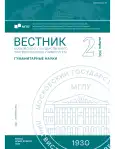Particular Traits of the Francophone Fairy Tale Discourse (based on the example of Moroccan fairy tales)
- Authors: Sokolova V.L.1
-
Affiliations:
- Moscow State Linguistic University
- Issue: No 2(896) (2025)
- Pages: 97-102
- Section: Linguistics
- URL: https://bakhtiniada.ru/2542-2197/article/view/284008
- ID: 284008
Cite item
Full Text
Abstract
The fairy tale being a special folklore genre is of particular scientific interest for analysis within the framework of linguistics, linguoculturology, sociolinguistics. Its aesthetic categories represent a heterogeneous component of the artistic, social, and cultural-historical codes. The article attempts to analyze the features of fairy-tale discourse based on the material of literary author’s Moroccan fairy tales. The purpose of the article is to identify and describe ethnocomponents, in particular, unmarked vocabulary, verbalization of chronotope, perception of space and symbolism. An attempt is made to analyze to what extent the Moroccan fairy-tale discourse follows the literary tradition of the fairy-tale genre. Based on the analysis, the specificity of the literary Moroccan fairy tale is described, in which the image of the original world of Morocco is intertwined with the European vision.
About the authors
Viktoria Leonidovna Sokolova
Moscow State Linguistic University
Author for correspondence.
Email: viviso.1602@gmail.com
Lecturer at the Department of Lexicology and Stylistics of the French Language Faculty of French
Russian FederationReferences
- Namychkina, E. V. (2010). Skazka kak literaturnyj zhanr = Fairy tale as a literary genre. Bulletin of Vyatka State University, 2(3), 103–108. (In Russ.)
- Propp, V. (2024). Morfologiya volshebnoj skazki = Morphology of a fairy tale. Moscow: KoLibri, ABC-Atticus. (In Russ.)
- Wundt, V. (2002). Psychology of peoples. Moscow: Eksmo Publishing House; St. Petersburg: Terra Fantastica.
- Bogatyreva, Zh. V., Zimina, N. Yu. (2015). A fairy tale as a cultural phenomenon. Mir nauki, kultury, obrazovaniya, 3(52), 293–295. (In Russ.)
- Halas, E. (2021). Simvoly i obshchestvo. = Symbols and society. Interpretative sociology. Translated from Polish. Kharkov: Humanitarian Center. (In Russ.)
- Bogatyreva, J. V. (2014). From myth to fairy tale (comparative analysis). The world of science, culture, and education, 6 (49), 510–512. (In Russ.)
- Gusev, V. E. (1967). Estetika fol’klora = Aesthetics of folklore. Leningrad: Nauka. (In Russ.)
- Plakhova, O. A. (2020). The aesthetic component of folklore consciousness. The Baltic Humanitarian Journal, 9-2(31), 301–304. (In Russ.)
- Benedict, R. (2024). Models of culture. Translated from English by A. K. Danilchenko; edited by I. V. Kuznetsov. 2nd ed., rev. and expanded. (In Russ.)
- Dobronitskaya, T. V. (1980) Stilistiko-sintaksicheskie osobennosti anglijskoj detskoj literaturnoj skazki = Stylistic and syntactic features of the English children’s literary fairy tale: PhD of Philology. Moscow. (In Russ.)
- Opie, I., Opie, P. (1983). The Classic Fairy Tales. Granada; London.
Supplementary files










